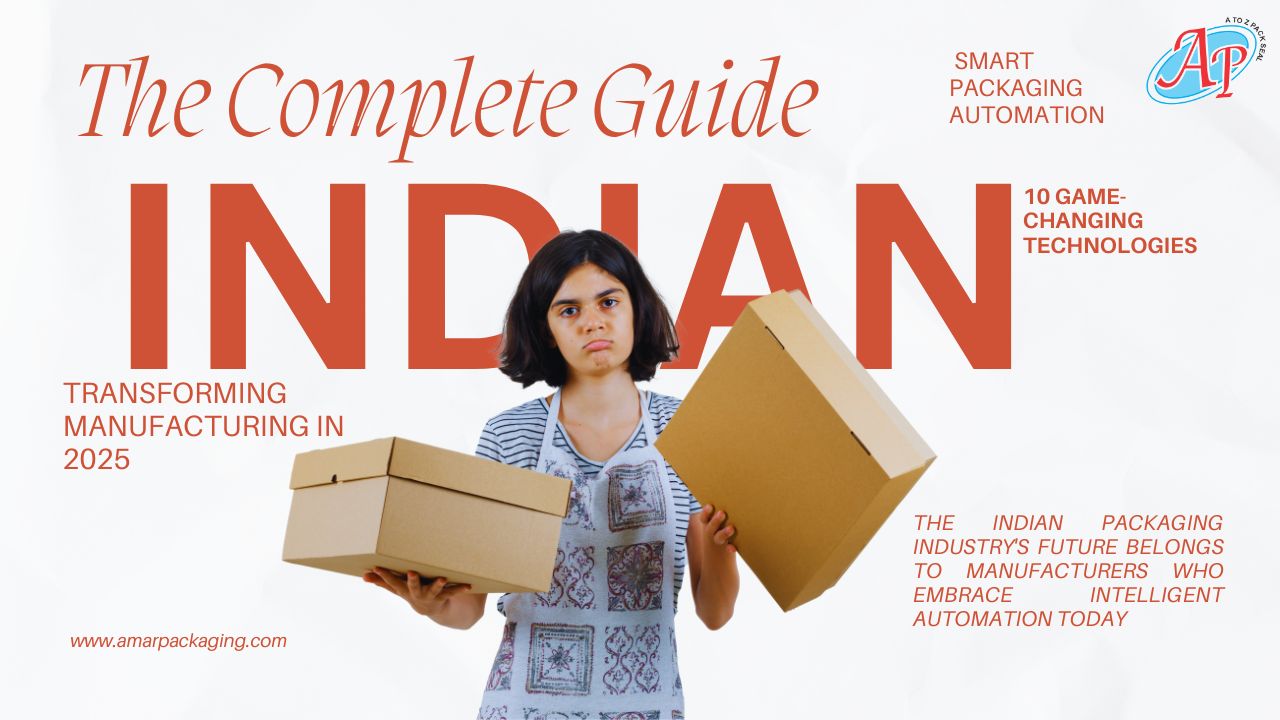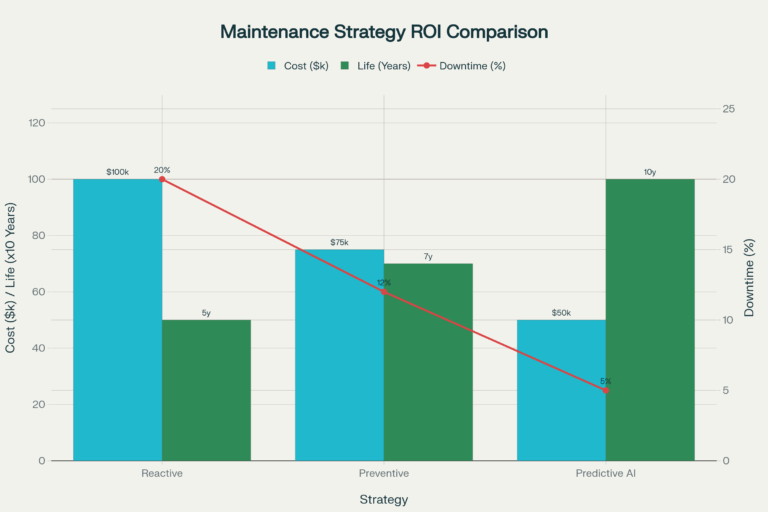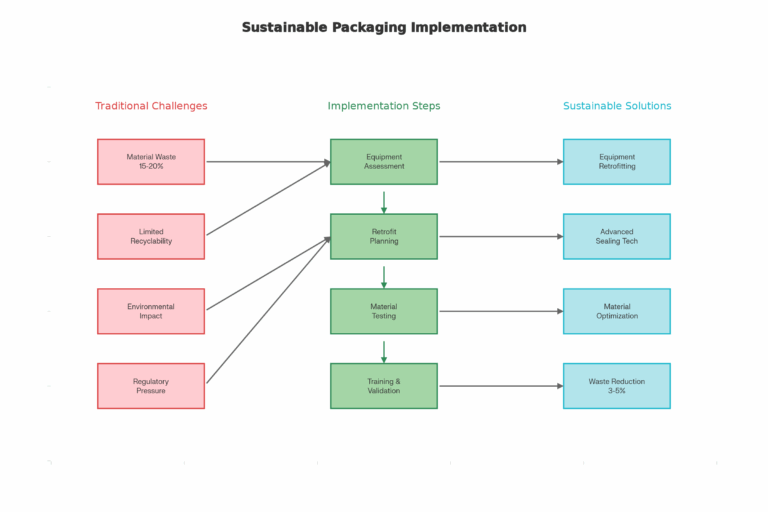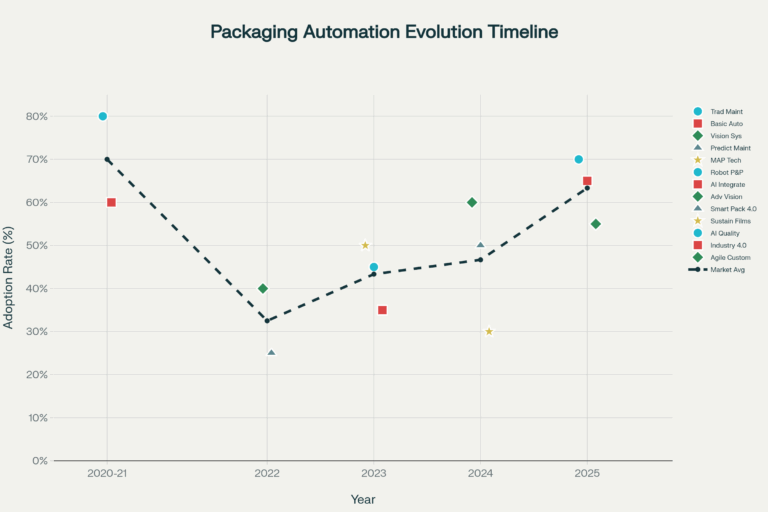
The Indian packaging industry stands at a pivotal transformation point. With the sector projected to reach ₹2.3 trillion by 2025, manufacturers are increasingly investing in advanced automation technologies to stay competitive. From AI-driven predictive maintenance to sustainable packaging solutions, the landscape is evolving rapidly—and companies that fail to adapt risk being left behind. As an industry expert who has witnessed the remarkable growth of packaging automation in India, I’ve identified 10 critical technology areas that are reshaping how manufacturers approach efficiency, sustainability, and profitability. This comprehensive guide addresses the most pressing challenges facing Indian packaging manufacturers today and provides actionable insights for technology adoption

The chart titled Maintenance Strategy ROI Comparison clearly demonstrates the financial and operational benefits of evolving from reactive to more proactive maintenance approaches. The Reactive strategy, while the least planned, incurs the highest Cost at $100k and results in the shortest equipment Life at 5 years and the highest Downtime at 20%. Stepping up to a Preventive strategy immediately shows an improved return, dropping the cost to $75k, extending life to 7 years, and cutting downtime to 12%. The most substantial gains are realized with the Predictive AI strategy, which achieves the lowest Cost at $50k, maximizes equipment Life to 10 years, and minimizes operational Downtime to just 5%. This data powerfully illustrates that the initial investment and effort required for advanced planning and technology, particularly with Predictive AI, yields significantly better performance and a higher overall Return on Investment.
Traditional maintenance approaches are bleeding Indian manufacturers dry. Unplanned downtime alone costs the manufacturing sector over ₹2,000 crores annually, with packaging lines particularly vulnerable due to their high-speed, continuous operations. Consider this: A typical VFFS machine operating at 150 bags per minute loses approximately ₹45,000 in revenue for every hour of unplanned downtime. Multiply this across multiple machines and shifts, and the financial impact becomes staggering.
Modern predictive maintenance systems deliver remarkable ROI: Studies show that AI enabled predictive maintenance can reduce unplanned downtime by up to 40% while cutting maintenance costs by 1560%. For Indian packaging manufacturers, this translates to: Reduced Equipment Failures: Early detection prevents 85% of catastrophic breakdowns Real-World Implementation Strategy Leading Indian packaging companies are deploying IoT sensors to monitor: Vibration patterns in filling machines and sealers Temperature fluctuations in heat-sealing systems Motor current signatures in conveyor systems Hydraulic pressure variations in press operations Extended Equipment Life: Assets last 2040% longer with proactive care Optimized Labor: Maintenance teams focus on value-adding activities rather than emergency repairs
Leading Indian packaging companies are deploying IoT sensors to monitor:
Extended Equipment Life: Assets last 2040% longer with proactive care
Optimized Labor: Maintenance teams focus on value-adding activities rather than emergency repairs
Case Study: A Mumbai-based flexible packaging manufacturer implemented predictive
maintenance across their VFFS lines and achieved 23% reduction in maintenance costs while
improving OEE from 76% to 89% within 18 months.
Most Indian manufacturers make the costly mistake of focusing solely on equipment purchase price. However, the initial cost represents less than 10% of total lifetime expenses. The remaining 90% includes energy, maintenance, labor, and downtime costs—areas where smart investments yield exponential returns.
Energy Consumption: Packaging equipment typically consumes 15-25% of a facility’s total energy. Modern servo-driven systems reduce energy consumption by 30-50% compared to pneumatic alternatives.
Material Waste: Poor equipment calibration leads to 15-20% material waste. Advanced packaging machines with precision controls reduce this to 3-5%, saving significant costs in high-volume operations.
Labor Inefficiencies: Manual interventions, changeover delays, and quality issues inflate labor costs. Automated systems with quick-changeover capabilities reduce labor requirements by 40-60%
For Indian packaging manufacturers, a comprehensive TCO analysis should include:
Initial Investment (10-15% of total cost)
Operating Costs (35-40%): Energy, materials, labor
Maintenance (20-25%): Preventive, predictive, emergency repairs
Downtime Impact (15-20%): Lost production, overtime, expedited shipping
End-of-Life Value (5-10%): Resale, recycling, disposal costs
ROI Calculation Example: A ₹50 lakh automated packaging line with 8% annual maintenance costs but 35% higher efficiency will break even within 2.5 years compared to manual operations, considering labor savings and reduced waste.
India’s push toward sustainable packaging is accelerating, driven by consumer awareness and regulatory pressure. However, processing biodegradable and compostable materials on existing VFFS equipment presents unique technical challenges.
Sealing Temperature Sensitivity: Bioplastics often require narrower temperature ranges (±2°C) compared to conventional films (±5°C). This demands precise thermal control systems.
Film Handling Characteristics: Biodegradable films may be:
Stiffer and less flexible, affecting forming operations
More susceptible to tearing, requiring gentler handling
Moisture-sensitive, demanding climate-controlled environments
Modern VFFS machines can be adapted for sustainable materials through:
Advanced Sealing Jaws: Temperature-controlled systems with precise heat distribution.
Film Tension Control: Servo-driven unwind systems prevent material damage.
Modified Cutting Systems: Laser cutting reduces material waste by 3% compared to mechanical cutting.
Enhanced Controls: Recipe-based systems store optimal parameters for different materials.
Implementation Timeline: Most VFFS retrofits for bioplastics can be completed in 2-4 weeks with minimal production disruption.

Packaging 4.0 represents the integration of cyber-physical systems, IoT, cloud computing, and cognitive computing into packaging operations. For Indian manufacturers, this isn’t just about technology—it’s about survival in an increasingly competitive global market.
Modern AI systems excel at:
Real-time defect detection with 99.9% accuracy
Predictive quality management based on process parameters
Adaptive process control that self-optimizes based on feedback
Vision System Integration: AI-powered cameras inspect up to 2,000 products per minute, detecting defects invisible to human operators while maintaining detailed quality records for traceability.
Leading Indian packaging companies are implementing digital twins to:
Simulate equipment performance before physical changes
Optimize production schedules based on real-time demand
Predict maintenance requirements with 95% accuracy
Companies implementing Packaging 4.0 solutions report:
20% improvement in productivity within 6 months.
15% reduction in quality defects through AI-driven control.
25% decrease in changeover times via digital optimization
Indian packaging manufacturers face an acute skilled labor shortage, with 68% reporting difficulty finding qualified operators. Robotic pick-and-place systems offer a strategic solution, providing consistent performance while addressing workforce challenges.
Delta Robots: Ideal for high-speed applications (120-140 picks/minute), priced from ₹15-25 lakhs
SCARA Robots: Perfect for precise positioning tasks, offering ±0.025mm repeatability at ₹8-15 lakhs
Collaborative Robots: Safe human-robot interaction, starting at ₹6-12 lakhs with integrated vision systems
Successful robotic integration requires:
Application Assessment: Determine optimal robot type based on cycle time, payload, and precision requirements
End-Effector Selection: Custom grippers designed for specific products (suction, mechanical, magnetic)
Vision Integration: 2D/3D cameras for product recognition and positioning
Safety Systems: Light curtains, emergency stops, and collaborative features
Typical payback periods:
High-volume applications: 12-18 months
Medium-volume operations: 24-36 months
Flexible manufacturing: 18-30 months
Hidden benefits include: Improved consistency, reduced worker compensation claims, and ability to handle multiple SKUs without retraining.
When evaluating VFFS machines for Indian operations, prioritize these factors:
Speed and Flexibility: Modern machines achieve 200+ bags per minute while handling multiple product formats
Modular Design: Systems that accommodate future expansion and product diversification
Energy Efficiency: Servo-driven systems reduce power consumption by 30-40% compared to pneumatic alternatives
Standard VFFS Systems:
Fixed forming tubes
Manual changeovers (30-60 minutes)
Basic HMI controls
85-90% efficiency rates
Advanced VFFS Systems:
Quick-change forming tubes (5-15 minutes)
Recipe-driven automation
Integrated vision systems
95-98% efficiency rates
Key vendor assessment criteria:
Local Service Support: Response time <24 hours for critical issues
Spare Parts Availability: 95% availability within 48 hours
Training Programs: Comprehensive operator and maintenance education
Technology Roadmap: Future upgrade compatibility
India’s MAP equipment market is growing at 6.0% annually, driven by cold chain development and food safety regulations. For manufacturers, MAP technology offers significant competitive advantages through extended shelf life and reduced food waste.
Product-Specific Gas Mixtures:
Fresh Meat: 25-45% CO₂, balance nitrogen (extends shelf life 200-400%)
Dairy Products: 20-30% CO₂ for bacterial inhibition
Ready Meals: Custom blends based on pH and moisture content
MAP System Types:
Tray Sealers: ₹8-45 lakhs, ideal for portion control
Thermoforming Systems: ₹25-80 lakhs, high-volume operations
Horizontal Flow-Pack: ₹15-35 lakhs, flexible applications
MAP investment justification:
Reduced Spoilage: 14-18% decrease in product returns
Extended Distribution: Access to distant markets through longer shelf life
Premium Pricing: 8-12% higher prices for fresh, preservative-free products
Payback Period: Typically 24-36 months for medium-scale operations, 18-24 months for high-volume facilities
Indian consumers increasingly demand personalized products, with 73% willing to pay premium for customized packaging. Agile packaging systems enable manufacturers to respond quickly to market trends while maintaining operational efficiency.
Recipe-Based Controls: Store parameters for unlimited SKUs, enabling changeovers in under 15 minutes
Servo-Driven Adjustability: Real-time modifications without manual intervention
Modular Design: Interchangeable components for different package formats
Successful agile packaging requires:
Demand Forecasting: AI-driven analytics to predict SKU requirements
Inventory Optimization: Just-in-time material management
Operator Training: Multi-skill development for system flexibility
Quality Systems: Consistent standards across all variants
Companies implementing agile packaging report:
35% faster time-to-market for new products
20% increase in customer satisfaction through customization
15% improvement in inventory turnover via demand responsiveness
India’s plastic ban and extended producer responsibility regulations are forcing rapid adoption of sustainable packaging materials. By 2025, 35% of packaging must contain recycled content, making retrofitting existing equipment a critical investment.
Equipment Evaluation Criteria:
Age and Condition: Machines under 10 years are prime retrofit candidates
Control System Compatibility: Modern PLCs enable
Mechanical Suitability: Frame strength
Common Modifications:
Sealing System Updates: Temperature-controlled jaws for sensitive materials
Film Handling Improvements: Tension control and edge guidance systems
Cutting Technology Upgrades: Laser systems for clean edges and reduced waste
Retrofit Investment: Typically 15-25% of new equipment cost
Alternative Costs: New sustainable-capable equipment costs 100% of retrofit investment
ROI Timeline: Most retrofits pay for themselves within 18-36 months through material savings and regulatory compliance

Advanced vision systems reduce quality defects by 90% while enabling real-time process optimization. For Indian manufacturers competing on quality and efficiency, vision integration is becoming essential.
2D Vision Systems excel at:
Label verification and positioning
Barcode and text reading
Surface defect detection
Color and pattern matching
3D Vision Systems enable:
Volume and height measurements
Complex shape analysis
Bin picking and robot guidance
Complete product profiling
Successful vision implementation requires:
Lighting Design: Consistent, controlled illumination for reliable detection
Camera Positioning: Optimal angles for complete inspection coverage
Processing Speed: Real-time analysis matching line speeds
Rejection Systems: Automated removal of non-conforming products
Vision system benefits:
Quality Cost Reduction: 60-80% decrease in customer complaints
Labor Savings: 70-85% reduction in manual inspection requirements
Throughput Improvement: 15-25% increase through continuous operation
Conduct comprehensive TCO analysis across all equipment
Implement basic predictive maintenance on critical assets
Assess current equipment for sustainable material compatibility
Establish baseline metrics for productivity and quality
Deploy AI-powered quality control systems
Retrofit high-value equipment for sustainable materials
Implement robotic pick-and-place in bottleneck areas
Upgrade to advanced VFFS systems for core products
Complete Industry 4.0 integration across all lines
Deploy agile packaging systems for customization
Implement MAP technology for premium products
Achieve full vision-guided quality control
Established in 1998, AmarPack Machines Pvt. Ltd. represents over 25 years of innovation and excellence in packaging machinery manufacturing. The company has evolved from a small-scale operation to become a trusted name across industries, serving customers throughout India and internationally. This quarter-century journey reflects consistent commitment to quality, innovation, and customer satisfaction.
AmarPack specializes in a complete range of packaging solutions including shrink wrapping machines, vacuum packaging systems, continuous band sealers, L-sealer shrink tunnel machines, and filling equipment. The company’s product diversity enables one-stop shopping for packaging requirements across multiple industries. Each product line incorporates latest technologies and industry-specific features.
AmarPack’s machines serve diverse industries including FMCG, pharmaceuticals, cosmetics, food processing, and chemicals. The company’s reputation for reliability, durability, and performance has earned trust across these demanding sectors. Customer testimonials consistently highlight machine longevity, consistent performance, and excellent after-sales support.
With exports spanning multiple continents, AmarPack demonstrates commitment to international quality standards and customer service. The company’s global presence reflects its capability to meet diverse market requirements while maintaining consistent quality across different operating environments. Export success validates the company’s technological competence and manufacturing excellence.
Founded in 1998 in Mumbai, India, AmarPack Machines Pvt. Ltd. is one of India’s leading manufacturers and exporters of premium packaging machines. Read More
GST No. 27AAZCA2345J1Z6
Get a quick quote from our experts. Fast response guaranteed!